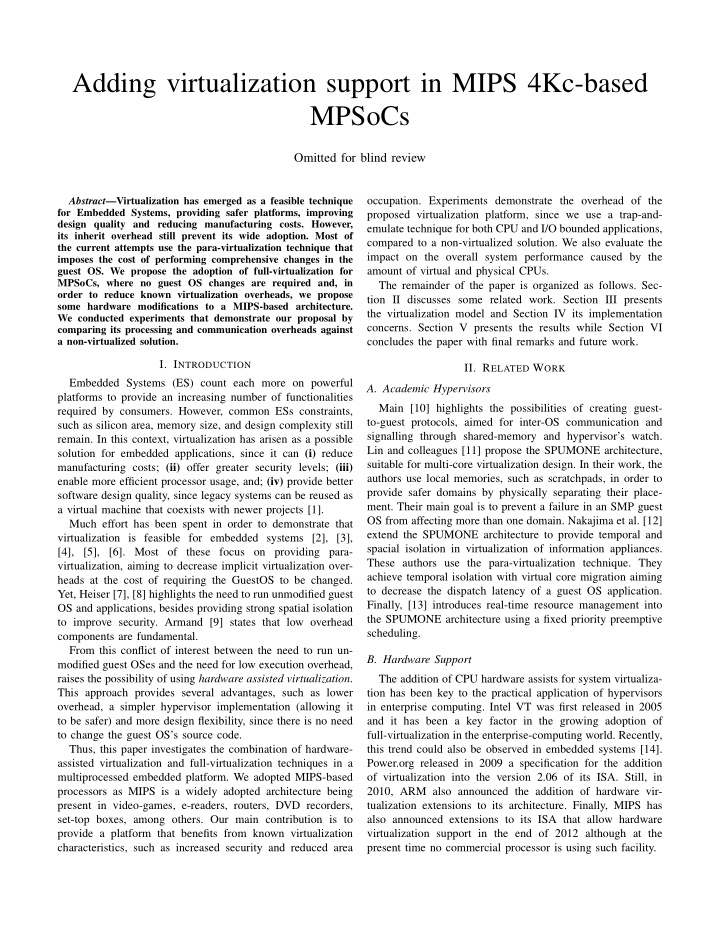



Adding virtualization support in MIPS 4Kc-based MPSoCs Omitted for blind review occupation. Experiments demonstrate the overhead of the Abstract —Virtualization has emerged as a feasible technique for Embedded Systems, providing safer platforms, improving proposed virtualization platform, since we use a trap-and- design quality and reducing manufacturing costs. However, emulate technique for both CPU and I/O bounded applications, its inherit overhead still prevent its wide adoption. Most of compared to a non-virtualized solution. We also evaluate the the current attempts use the para-virtualization technique that impact on the overall system performance caused by the imposes the cost of performing comprehensive changes in the amount of virtual and physical CPUs. guest OS. We propose the adoption of full-virtualization for MPSoCs, where no guest OS changes are required and, in The remainder of the paper is organized as follows. Sec- order to reduce known virtualization overheads, we propose tion II discusses some related work. Section III presents some hardware modifications to a MIPS-based architecture. the virtualization model and Section IV its implementation We conducted experiments that demonstrate our proposal by concerns. Section V presents the results while Section VI comparing its processing and communication overheads against a non-virtualized solution. concludes the paper with final remarks and future work. I. I NTRODUCTION II. R ELATED W ORK Embedded Systems (ES) count each more on powerful A. Academic Hypervisors platforms to provide an increasing number of functionalities Main [10] highlights the possibilities of creating guest- required by consumers. However, common ESs constraints, to-guest protocols, aimed for inter-OS communication and such as silicon area, memory size, and design complexity still signalling through shared-memory and hypervisor’s watch. remain. In this context, virtualization has arisen as a possible Lin and colleagues [11] propose the SPUMONE architecture, solution for embedded applications, since it can (i) reduce suitable for multi-core virtualization design. In their work, the manufacturing costs; (ii) offer greater security levels; (iii) authors use local memories, such as scratchpads, in order to enable more efficient processor usage, and; (iv) provide better provide safer domains by physically separating their place- software design quality, since legacy systems can be reused as ment. Their main goal is to prevent a failure in an SMP guest a virtual machine that coexists with newer projects [1]. OS from affecting more than one domain. Nakajima et al. [12] Much effort has been spent in order to demonstrate that extend the SPUMONE architecture to provide temporal and virtualization is feasible for embedded systems [2], [3], spacial isolation in virtualization of information appliances. [4], [5], [6]. Most of these focus on providing para- These authors use the para-virtualization technique. They virtualization, aiming to decrease implicit virtualization over- achieve temporal isolation with virtual core migration aiming heads at the cost of requiring the GuestOS to be changed. to decrease the dispatch latency of a guest OS application. Yet, Heiser [7], [8] highlights the need to run unmodified guest Finally, [13] introduces real-time resource management into OS and applications, besides providing strong spatial isolation the SPUMONE architecture using a fixed priority preemptive to improve security. Armand [9] states that low overhead scheduling. components are fundamental. From this conflict of interest between the need to run un- B. Hardware Support modified guest OSes and the need for low execution overhead, raises the possibility of using hardware assisted virtualization . The addition of CPU hardware assists for system virtualiza- This approach provides several advantages, such as lower tion has been key to the practical application of hypervisors overhead, a simpler hypervisor implementation (allowing it in enterprise computing. Intel VT was first released in 2005 to be safer) and more design flexibility, since there is no need and it has been a key factor in the growing adoption of to change the guest OS’s source code. full-virtualization in the enterprise-computing world. Recently, Thus, this paper investigates the combination of hardware- this trend could also be observed in embedded systems [14]. assisted virtualization and full-virtualization techniques in a Power.org released in 2009 a specification for the addition multiprocessed embedded platform. We adopted MIPS-based of virtualization into the version 2.06 of its ISA. Still, in processors as MIPS is a widely adopted architecture being 2010, ARM also announced the addition of hardware vir- present in video-games, e-readers, routers, DVD recorders, tualization extensions to its architecture. Finally, MIPS has set-top boxes, among others. Our main contribution is to also announced extensions to its ISA that allow hardware provide a platform that benefits from known virtualization virtualization support in the end of 2012 although at the characteristics, such as increased security and reduced area present time no commercial processor is using such facility.
Recommend
More recommend